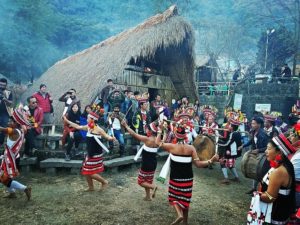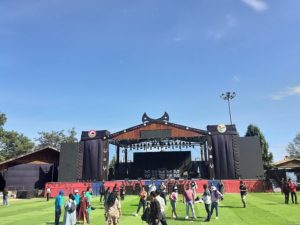As the drumbeats echo through Nagaland’s Kisama Heritage Village today, the starting of the Hornbill Festival draws visitors to experience a vibrant celebration of unity. Jnanendra Das writes about this 10-day extravaganza
 Music is an integral part of tribal communities, serving purposes far beyond recreation. Didactic performances and folk music transcend mere melody, acting as a bridge to connect with ancestors, nature, and future generations. Through songs and music, invaluable knowledge, stories, and traditions are preserved and passed down. Celebrations and festivals often centre around this musical heritage. In Northeast India, home to over 200 tribes, the winter months transform the region into a vibrant land of festivals, drawing visitors eager to experience its cultural richness.
Music is an integral part of tribal communities, serving purposes far beyond recreation. Didactic performances and folk music transcend mere melody, acting as a bridge to connect with ancestors, nature, and future generations. Through songs and music, invaluable knowledge, stories, and traditions are preserved and passed down. Celebrations and festivals often centre around this musical heritage. In Northeast India, home to over 200 tribes, the winter months transform the region into a vibrant land of festivals, drawing visitors eager to experience its cultural richness.
Starting today is one of the oldest and most celebrated annual festivals of the region, Nagaland’s ‘Hornbill Festival’. Dubbed the “festival of festivals,” it began in 2000 as a modest three-day event in Kohima. Since then, the festival has grown into a major tourism attraction, now spanning 10 days. From December 1st to 10th, visitors can immerse themselves in tribal life, experiencing local food, traditional games, music and dance, along with the finest handicrafts and textiles.
 Hosted at Kisama Heritage Village, located on the slopes between Kigwema and Phesama villages in the Kohima District of Nagaland, this year will see participation from the 17 tribes of Nagaland. This whole village becomes the venue for the festival with a main stage arena where the music festival, various dances, martial arts contests and the final “unity dance” takes place.
Hosted at Kisama Heritage Village, located on the slopes between Kigwema and Phesama villages in the Kohima District of Nagaland, this year will see participation from the 17 tribes of Nagaland. This whole village becomes the venue for the festival with a main stage arena where the music festival, various dances, martial arts contests and the final “unity dance” takes place.
As tribes come together at Kisama Heritage Village, their performances embody the spirit of collective harmony, much like the instruments they cherish. Among these, the Naga log drum stands out as a powerful symbol of togetherness and tradition.
Much like the festival itself, the log drum represents collaboration. Carved from a single colossal tree, this massive wooden instrument cannot be played by just one person. Instead, it requires the synchronised effort of many from the same tribe, each contributing their part to create something larger than themselves.
A Naga log drum is classified as an idiophone, an instrument that produces sound primarily through vibrations. It goes by different names depending on the tribe and region it originates from. While its primary function is that of a drum, it is revered like an idol. The tradition of crafting these remarkable log drums is practised by various Naga tribes, including the Konyak, Ao, Yimchunger, Sangtam, Phom, Khiamniungan, and Chang in Nagaland, as well as the Wancho in Arunachal Pradesh. These drums are played during important occasions such as the celebration of victory in war, village feasts, funerals of respected individuals, and even during solar or lunar eclipses. Each event is marked by a distinct rhythm.
A typical log drum consists of the head, chest, wing, neck, body, tail, and drumsticks or beaters. The head is intricately carved with representations of buffalo, mithun or tiger heads, with the mouth and eyes painted black. The log drum is usually kept in the Morung (a social institution where unmarried Naga men learn about their tribe’s customs and traditions). The size of the drum reflects the size of the village—larger villages boast larger drums.
(Source: Northeast Zone Cultural Centre, Dimapur)
Over time, the use of this instrument has also become varied. Today, the log drum is still used by each tribe, especially, to accompany festival performances and get a special highlight during the Hornbill Festival. The Naga log drum is a representation and manifestation of the beliefs the age-old Naga tribesmen stood for. It is a symbol of the past kept alive and incorporated into the way of the present.
As the 10-day festival begins today, December 1, the air is filled with an eclectic mix of energy. The state’s Department of Tourism has made all necessary arrangements, and while locals are excited to showcase their rich heritage and culture, there is also a subtle concern for the ecological impact of the event.
“As someone from Nagaland, the Hornbill Festival holds a special place in my heart. I’ve been attending the festival since 2018, and each year has been a unique experience. The festival offers so much to learn, explore, and enjoy but only if you have the resources”, Tiapong Tzudir, a 25-year-old YouTuber and Young India Fellow at Ashoka University, Sonipat, shares his mixed emotions
On this year’s preparations, Tzudir adds, “The music showcased during the Hornbill Music Festival is a blend of genres. While not everything is traditional, it gives a glimpse of Nagaland’s music scene—from gospel and choral music to hip-hop and beyond. This year’s inclusion of partner countries (Wales and Japan) seems intriguing, as it offers an opportunity for cultural exchange and mutual exposure.”
Yatra Kid, the concerned youth from Changki Village, Mokokchung, and a YouTuber, expresses his hopes for the festival’s future: “I hope the Hornbill Festival continues to grow but stays true to its cultural roots, rather than conforming to mainstream trends. It’s crucial that the festival remains a genuine reflection of Nagaland’s heritage and identity in order to sustain its growth.”
For many local artisans and craftsmen creating traditional handicrafts and garments, the Hornbill Festival is a time of great opportunity and profit. Kekhriesilie Suohu from Kohima shares, “I try to make my way to Kisama almost all 10 days of the festival. I mostly enjoy watching the wrestling of my tribe (Angami), even though I don’t get time to practice or participate myself. It’s really cold during this time of year, but the enthusiasm of the people keeps it warm—or maybe it’s just the rice beer and pork!” (laughs).
Dibyajyoti Das, a bank employee based in Kohima, says, “During my four years of college, we had planned to visit Hornbill at least once, but that never happened as we struggled to maintain 75% attendance. However, as luck would have it, my first posting was in Kohima. There’s nothing like the energy of the Hornbill Festival. I’m fascinated by the local products that come from different corners of the state—it’s a foodie’s paradise. In the main festival, I particularly enjoy the Unity Dance that concludes the event. There’s a huge bonfire, and all the participating tribes hold hands, dancing together in concentric circles. That is a sight to behold.”
The Hornbill Festival is a celebration of more than just music, dance, and handicrafts—it is a vibrant showcase of Nagaland’s rich cultural tapestry and a testament to the resilience of its heritage. As the festival continues to evolve, incorporating modern elements and international collaborations, it remains rooted in the spirit of community, unity, and ancestral pride. For locals, it is a time of cultural affirmation and economic opportunity, while for visitors, it offers a window into the heart of the Naga way of life.
Image source: Wiki commons



